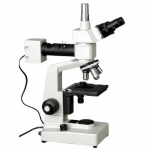- Show results for
- Share
How Does A Metallurgical Microscope Work?

What Is A Metallurgical Microscope?
A metallurgical microscope is a sort of light microscope that uses referred white light. Of course, the samples you need to test are various such as metals, plastic, biology slides, cells, living microorganisms, etc. And all these samples vary in their consistency. A metallurgical microscope is applied for the high-power light source. These microscopes are generally applied in metallography, forensics, processing plastics, an inspection of metals, laser systems, and many other fields of material science.
Metallurgical microscopes are divided into 4 major types:
Upright Microscopes are used with referred light only, in which light goes from the lamp-house and is applied for non-transparent samples;
Upright Metallurgical Microscopes with referred and supplied lights, where light may come from the top or bottom of the light sources and can be applied for testing the transparent and non-transparent samples;
Inverted Metallurgical Microscopes consist of the lamp house for referred illumination.
Boom Stand Metallurgical Microscopes.
How Does Metallurgical Microscope Work?
The Metallurgical Microscopes is a significant high-power complex microscope that may view non-transparent samples and objects. It isn’t required to pass the light through the object or sample on the metallurgical microscope to be obvious, as the supplied light doesn’t come from the bottom. They pick up the referred light off the sample or object which means that the light comes from the top, from the objectives and eyepiece.
The metallurgical microscopes apply a specific illuminator and objective installation called “EPI illumination”, or referred light. The lights are supplied from the box that is fixed between the microscope head and the objective turret and referred to with the mirror. The light is supplied through the specific objective that allows the light to be referred to the sample or object up into the prism, and be visible in the eyepiece. The light generates from the illumination box, then supplied to the glass-covered with the reflecting component. The light comes from the angle and reflects down into the object, focused on the object or sample, and then supplied at various angles on the reflecting component, which allows it to go through the glass and not reflect it off. After that, it maintains the eyepiece and becomes visible to the human eye.

*Diagram of the light passing in a metallurgical microscope.
You may expect to see an image similar to this while applying the metallic sample in the microscope, however, as it can view the non-transparent object, there are different non-metallic samples as well.

Specific Features To Metallurgical Microscope
The subsequent imaging modes differ metallurgical microscopes from other microscopes for biological research:
Differential Interference Contrast - is a specific technique that renders 3D imagery with a crucial amount of comparison to samples under the microscope. It is applied with IR or optical light for the imaging of thick biological material or samples for better research.
Polarized light - a sort of light by the polarizer positioned nearby to the microscope eyepiece. It is commonly applied to viewing crystalline generation of non-transparent metals.
Darkfield Illumination - is specific lightning where the central light is restricted to allow indirect sunlight to strike the transparent and spotless samples. When the image is referred to at inclined angles with a dark background that provides the revelation of non-flat spaces.
Brightfield Illumination - is the other lighting aspect that offers you to view dark samples with a light background. The most common microscopic technique allows viewing cells without spotting by making the cross-section of extensively structured samples possible. The thicker the sample is, the more the microscope transmits light.
What Metallurgical Microscope To Choose?
Of course, if you are looking for the basic brightfield metallurgical microscope, we would recommend the AmScope ME300TZ-3M with a camera for digital imagery.
The AmScope metallurgical microscope includes a 3MP digital camera that captures images and videos, thus allowing you to view the stream on your PC. There are four magnification settings (40X, 100X, 400X, and 1000X) available with EPI halogen illumination. The microscope comes with a 30-degree inclined 360-degree rotatable head and a two-layer mechanical stage.
The included Windows software allows image maintenance, development, and measurement tools. The metallurgical microscope includes several developed features, including improved features such as image-stitching and extended depth-of-focus.
The AmScope Metallurgical Microscope is a perfect device for different industrial applications such as silicon wafer inspection, industrial inspection, quality control, and foundries.
Conclusion
A metallurgical microscope differs from the other microscopes as it applies light coming from above the sample. These microscopes are applied in various industries such as the manufacturing of metallic products, semiconductors, plastics, and many others.
The metallurgical microscope is a significant device for the detailed research of samples at a microscopic level. It may stain and have rough spots on different materials that are created while producing that must be corrected. It is a crucial device that allows researchers to examine several specific samples.












